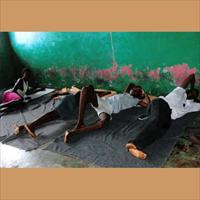UGANDA: Overcrowded prisons heighten TB risk

Dr Michael Kyomya is responsible for the health of almost 5,000 inmates in Uganda's Luzira Prison, but his caseload is not the biggest challenge - the architecture is. The high walls just outside his office in the prison's medical facility not only keep the prisoners in, but also infectious diseases like tuberculosis (TB).
"Before, [designing prisons] was about restricting points of escape, not ventilation for those inside," Kyomya told IRIN/PlusNews. When Luzira was built in 1927, the population of Uganda was about four million; today it is about 30 million, but the prison has never been expanded or remodelled.
The facility was built to house 600 inmates but now holds more than six times that number. "Prison acts as an incubator for disease," said Dr Johnson Byabashaija, the commissioner of prisons. The national prison population is growing at a rate of roughly 10 percent per year.
It is impossible to say just how many inmates have TB, but Uganda Prisons Service officials estimate the rate of infection at about 20 percent, and that about half of these cases are co-infected with HIV. An inmate population of about 26,000 means there are more than 5,000 with TB and about 2,500 with both HIV and TB.
With an estimated 80,000 new TB infections occurring annually, Uganda is ranked 15th on World Health Organisation list of 22 countries that bear 80 percent of the global TB burden. Uganda also has one of the lowest TB cure rates in the world – about 32 percent - according to a 2008 WHO report.
Kyomya put the cure rate in prisons at about 20 percent, and attributed the high level of respiratory diseases primarily to the lack of ventilation, poor health facilities, and other problems in the prison system. According to Byabashaija, TB and other respiratory infections are the leading cause of mortality in the prison system, with about 200 deaths annually.
Poor disease management and risk of re-infection
Luzira holds about five percent of Uganda's prisoners, and is one of the only facilities with any kind of medical care. Inmates at other prisons are often referred to district medical facilities, which sometimes do not have the resources to treat sick prisoners.
An inmate from the western district of Mbarara, who declined to give his name, told IRIN/PlusNews he was moved from the prison near his home to a jail in Jinja, east of the capital, Kampala, and forced to do hard labour, even though his wardens knew he was HIV-positive. After he collapsed in 2007, he was transferred to the medical facility at Luzira, where he was diagnosed with TB.
He will stay in the medical facility at Luzira until his TB is no longer considered 'active' or infectious, which can take from two weeks to several months, but prisoners are often returned to the general wards while they are still contagious, and if one person in the overcrowded cells has TB, it is likely that within days other prisoners will also be infected.
The lack of a centralised record keeping system means doctors struggle to follow up prisoners, who are often transferred between institutions or discharged before consulting medical personnel for a service referral at the inmate's next destination.
Kyomya said the fact that there were no isolation wards also led to unnecessary re-infection. Samuel Kizza, 39, became infected with TB at Luzira in 2004 and now has it again. His doctor said if a prisoner has had TB in the recent past and again comes in contact with the disease, he has little chance of avoiding re-infection, especially if his immune system is weakened by HIV.
The Uganda Prisons Service is building new prisons in several areas of western and northern Uganda, while renovating other prisons around the country, and recently partnered with the International Committee for the Red Cross (ICRC).
Pilot programmes are being run at Luzira and two other facilities, with the aim of building capacity in the prison service to improve prisoners' health by strengthening diagnosis, care and prevention.
 Back and Next - Back and Next
Back and Next - Back and Next See Also - See Also
See Also - See Also